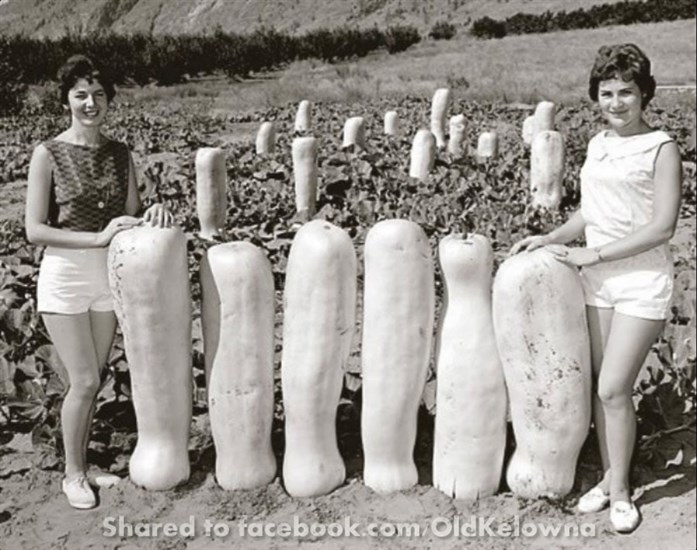
Zucca melons once were a common sight in the South Okanagan.
Image Credit: FACEBOOK/Old Kelowna
May 15, 2022 - 8:35 AM
Colourless, tasteless, 100-pound zucca melons once dotted the landscape of the South Okanagan, the only place in Canada where they were grown.
Originally from Africa, the zucca melon gained popularity in the 1930s and ‘40s in the Osoyoos area when the Southern Okanagan Lands Project wanted to find a way for growers to make a living until their fruit trees began bearing fruit.
The melons are actually gourds and were grown in Orville, California before they came to the Okanagan when Hermann Gummel obtained five seeds and grew them in his Osoyoos orchard, according to the Okanagan Heritage Society.
Video Credit: Royal BC Museum
"Different Melons" (ca. 1945) - Royal BC Museum - AAAA2464
The zucca melon is one of the largest gourds in the world. They can weigh more than 100 pounds with white, tasteless flesh which makes them ideal for dying and processing in items like cakes and cookies, according to a report from the Okanagan Heritage Society.
With sufficient seed available and increased demand for the melons due to Second World War restrictions on imports, the area grown with melons expanded rapidly, as more growers started planting them.
Plants, when well fed with manure and commercial fertilizer, would cover an area of from 20 to 25 square feet, so most growers found that they didn't have enough room for zucca melons.
After few years there were only four to six growers left with large enough acreage to grow them. In some years there must have been nearly a thousand tons of melons shipped out of Osoyoos, according to the heritage society.
When wartime restrictions on imports declined, so too did the demand for the zucca melon and by the middle of the ‘50s, farmers stopped growing them.
Nowadays, seeds are still sown and sold in part to remember the Okanagan history of the zucca at The Grist Mill and Gardens in Keremeos.

Zucca melons once were a common sight in the South Okanagan.
Image Credit: FACEBOOK/Old Kelowna
The best time to see zucca melons is in late summer, early fall and seeds are sold in early February and March, said manager Chris Mathieson.
“Imagine the most boring zucchini you’ve ever eaten, that’s what a zucca is actually like,” he said.
“They were graded as filler in industrial foods. If you had jam and you needed fruit you could cut up pieces because it was like zucchini that way. It was really common but then it got phased out because it was really hard on the soil, kind of like ginseng at one point,” he said.
“It disappeared except in people’s memories and in photographs and then in the ‘80s this heritage site was created and we got really interested in heritage crops. So our head gardener at that time went off in search of seeds for this mysterious zucca thing that she’s seen pictures of and found one guy in Illinois that still grew them.”
Over subsequent years, the mill held zucca growing contests and the gourd has become associated with the heritage site.
“They’re kind of a weird, cool, novelty if you have super rich soil and a whole lot of patience,” Mathieson said.
He doesn’t expect to see a resurgence in zucca melon popularity anytime soon.
“They’re a great connection to our agricultural past but they don’t make a whole lot of sense. They take up way too much land, I mean you can grow four zuccas or hundreds of pounds of grapes," he said.
To contact a reporter for this story, email Carli Berry or call 250-864-7494 or email the editor. You can also submit photos, videos or news tips to the newsroom and be entered to win a monthly prize draw.
We welcome your comments and opinions on our stories but play nice. We won't censor or delete comments unless they contain off-topic statements or links, unnecessary vulgarity, false facts, spam or obviously fake profiles. If you have any concerns about what you see in comments, email the editor in the link above.
News from © iNFOnews, 2022